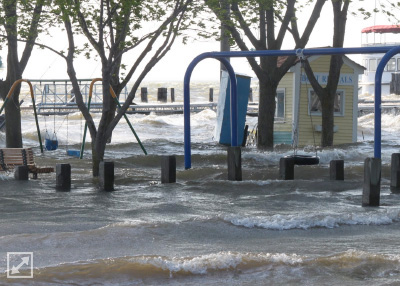Landscape Lenses
Physical Landscape : Climate

Lake Champlain flooding in Burlington, Vermont, Spring 2012Climate describes the overall patterns of weather observed in an area. All together, air temperature and pressure, humidity, cloudiness, precipitation, and wind create weather patterns, or climate. From precipitation to wind and ice, weather is a process that affects the landscape at every level. Until recently we perceived the global climate and its resulting weather regimes to be fairly stable. But examination of pollen and arctic ice cores has shown us that climate change is inevitable. We know for example that Vermont was once much, much colder, and was buried under a mile of ice. We also know that historically plants and animals have been able to adapt to climate change by migrating to more hospitable areas, but that some periods of rapid climate change coincided with mass extinction events.
Though we are due for another ice age soon, and scientists continue to grapple with global warming models, for now we will focus on the current climate in Vermont. For such a small state, the weather varies dramatically from one region to another. For example, the Champlain Valley is some times referred to as the “banana belt” of Vermont. It is not uncommon for northern Vermont to be in the middle of a full winter blizzard with over two feet of snow accumulating, while the Champlain Valley is under blue skies without an inch of snow on the ground. Skiers and sailors know that much of the weather in Burlington can be seen coming from the West across the Adirondacks, but when a North wind blows, it brings with it brisk air from the Canadian shield. Climate can vary more locally as well. To experience the effect of microclimate in Vermont, you could walk along the edge of a stone wall and feel the difference between the warm sunny hay field on one side and the cool moist forest on the other side.